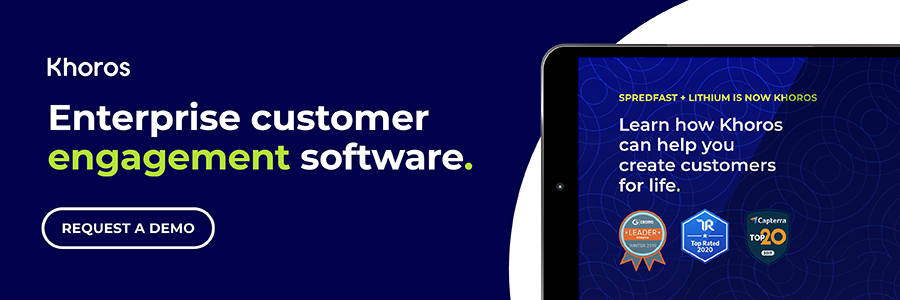 Logo
Logo
EXPERT INSIGHTS
Jul-02-2019
The essential social media metrics for success
Jackson Kushner
Social media success isn’t driven by who has the most followers or likes. Tangible success is measured by a brand’s ability to leverage social media channels to drive conversions, sell products, build awareness, help users, and improve engagement.
Faithfully illustrating social media's impact on a business has plagued marketers since its inception. How can you secure executive buy-in for marketing strategies and larger budgets if you can’t confidently demonstrate how social media contributes to an organization’s business goals? According to Forrester Research, nearly half of marketers struggle to demonstrate the impact of their social media efforts.
The first step to maximizing your effectiveness with social media is to understand which social metrics drive success for the unique needs of your brand. Social media analytics provide a variety of opportunities to both prove and improve social media's value.
Many businesses and organizations build their social media strategy before completing that first essential step: Determining which metrics they will measure, how they'll measure them, and why those KPIs matter. These metrics should be determined in the planning phase of a marketing strategy — you can’t back into social media measurement and expect reliable data and optimal results.
In this post, we’ll take a look at….
How to plan your social media strategy
As social media marketers, it can be easy to get lost in adding up the likes and retweets, losing sight of the true intent of your strategy: business need. Our three social media planning recommendations will help you connect your social strategy to your brand:
1. Align your social media content with your brand messaging
The dilemma
This may seem like common sense, but do you know if your social strategy is truly in line with how your social pages talk about your business? Different departments will often discuss the same pieces of your business in different ways. From product lines to geographies, different aspects matter to different parts of your organization.
Our advice
One method of connecting your social strategy to your business is investing the time to build a social content tagging approach that will allow you to bring insights to different groups. The way you tag your content is how you’re going to report on it. If your tagging doesn’t reflect your business language, you’re only seeing half the picture.
An example
A fitness organization might tag their content based on content pillars like nutrition or by-product, such as, say, outerwear. But to build a system that represents your whole business, you need to expand your tags even further. Ask your colleagues how they talk about the business at a macro level. What kind of customers are you targeting? Potential, new, loyal? Are you targeting specific regions like North America or EMEA? What about interests like hunting or fishing?
This is not an “either or” for your business. This is a “both and.”
2. Plan for your customers to interact on social (a lot)
The data
It’s official. Social media is the channel of choice for customers to reach out to brands. 52% of millennials report using social media as a support channel in 2016. Customers expect a quick response from brands when they reach out on social media, and rising inquiry volume can create a headache for social media and customer care teams alike.
The dilemma
Last year, to learn more about how brands are using social media for customer care, we looked at the tweets of twenty enterprise brands in our social iceberg report. We found that the majority of social content created by brands is not 1:many marketing messages, but 1:1 interactions, initiated by customers. Five percent of interactions were started by the company while 95% were responses to customers. To put things in perspective, 89% of the time brands don’t respond when they are mentioned online.
Social media care is just getting started. You need to be ready for this increase in volume and develop a plan for how, and when, to respond. Who are the types of people that reach out? What volume have you had in the past? What types of questions do you answer?
Our advice
Run an analysis on your 1:1 interactions and understand what you might be missing. Content tagging can be helpful here too for categorizing what’s coming in, as well as what’s going out. Distinguish between a problem and a question and narrow down an issue to a specific region.
3. Make time for social innovation in addition to social ROI
The dilemma
Last but not least, the real number on the top of every marketer’s mind: Budget. Striking the perfect balance between investing in proven tactics and new opportunities can keep any marketing team running smoothly for years. If you can’t show your value, you shouldn’t expect to keep and increase your social media marketing budget.
Our advice
We recommend shaping your budget around the 70/20/10 rule.
- 70% percent of your budget goes to proven methods, the workhorses of your marketing campaigns
- 20% percent goes toward what you believe will be your next workhorses, that still need a few trial runs
- 10% percent should be experimental. These are the risky ideas that won’t necessarily contribute to tangible ROI but could pay off down the road. This 10% is also your direct feed into the 20% section and encourages you to make room for R&D
The 70/20/10 rule helps you understand how good you are at moving tests to practicality, while incubating new tactics.
Of course, it’s also important to understand what kind of ROI you can expect from your digital solutions.

Important metrics for social media marketing & care
Micro metrics
These seven social media metrics are focused on the data and statistics that can inform your strategies and generate parsable reports. They provide the insight necessary to align your social media and business goals, as well as communicating them to executives.
Social media metrics to track:
1. Post volume
Each time you post to social media, it improves or diminishes your relationship with your followers. There is an ideal cadence for every brand and every channel.
2. Stories consumption
Instagram Stories has more than 300 million daily users, per Facebook stats. Understand how people are watching your stories.
3. Relevance score
Like SEM on Google, Facebook uses a 1-10 “relevancy” score to give paid posts more or less exposure. Every ad on Facebook (and Instagram) has a relevancy score, based on how well an ad is performing, positive interactions, and negative interactions.
4. Video minutes viewed
Total and average minutes watched are better metrics than video views, especially on Facebook where just three seconds counts as view. Video is growing in relevance and prevalence.
5. Response time
Speed matters. According to our survey, about half of social media users expect a brand to respond to their message or post, about a complaint, within three hours.
6. Post-click conversion Rate
If social is driving people to your site or landing page, the click by itself isn’t really a success metric. What matters is what happens after the click. How many people do the thing you want them to do.
7. ROI
The formula for calculating ROI is always return minus investment, divided by investment, expressed as a percentage.
Macro Metrics
This set of social media metrics is focused on cultivating a larger picture of how your social media campaigns connect with your brand's goals. You will use the data and statistics from your micro metrics to help evaluate and evolve your macro metrics and strategies.
1. Content resonance metrics
While you can’t attribute vanity metrics such as follows, likes, shares or retweets directly to sales, they shouldn’t be abandoned entirely. They will help the people who are executing social media marketing on an everyday basis to know what kind of content interests your audience. Engagement metrics such as call to action (CTA) clicks get us closer to proving business value. If your goal is to increase conversions on your website, conversion tracking pixels allow you to tie actions that people take on your site back to an action they took on social media.
Keep in mind that consumers do not necessarily need to overtly engage with social media content to notice it or be influenced and persuaded by it. Within paid social media, Facebook and Instagram offer a metric called Estimated Ad Recall Lift. This is an amalgamation of the types of actions that people can take with your content, including passive activity, such as dwell time. Bottom line — don’t underestimate your impact. The numbers you report should capture those who are reading your content as well as those who are overtly engaging.
2. Customer lifecycle metrics
Measure social media in the context of a larger marketing initiative. Customer lifecycle metrics help you measure against the particular lifecycle phase that you were targeting for that program. For example, measuring mentions when driving discovery, or measuring website traffic referrals when driving exploration.
3. Brand health metrics
We can now actually measure brand lift data, such as awareness, favorability, message association and purchase intent. Millward Brown and Nielsen Brand Effect offer paid studies you can invest in, or Facebook and YouTube offer similar studies with a lower price of entry.
4. Customer satisfaction and customer service metrics
Are your clients getting the value they were expecting? Are they loyal? There is no better way to measure the impact of your brand loyalty efforts than by getting direct feedback. With Net Promoter Score (NPS) and Customer Satisfaction (CSAT) industry standard question formats, you can survey clients in a structured way to better measure and more importantly, improve your customer service. To take this one step further, track how negative interactions change loyalty over time — identifying the rate of growth for customers from the time of their first negative interaction compared to those with only positive interactions.
Compare how negative sentiment changes loyalty over time.
Customer service metrics go hand in hand with customer satisfaction metrics. If you’re exceeding customer expectations, your customers will be more satisfied. Track decreases in social media response time, as well as the number of cases handled and the cost to resolve customer issues.
5. Business outcome and impact on sales
This is the hardest to measure because it’s very difficult to get specific data from social media platforms that will help you put social media into the conversation about attribution. The goal is to be able to show how any kind of social media engagement contributes to the entire customer lifecycle — so you can assign an actual portion of a sale and subsequently loyalty to each marketing channel, which includes social media.
One way to track lead attribution is to append tracking parameters to every link you share on social media so you can analyze your results through Google Analytics or another preferred analytics tool.
Evolve your social media metrics
We love helping brands grow and optimize their social media marketing. If you would like to learn more about how to take your social media campaigns to the next level, Khoros is here to help!











